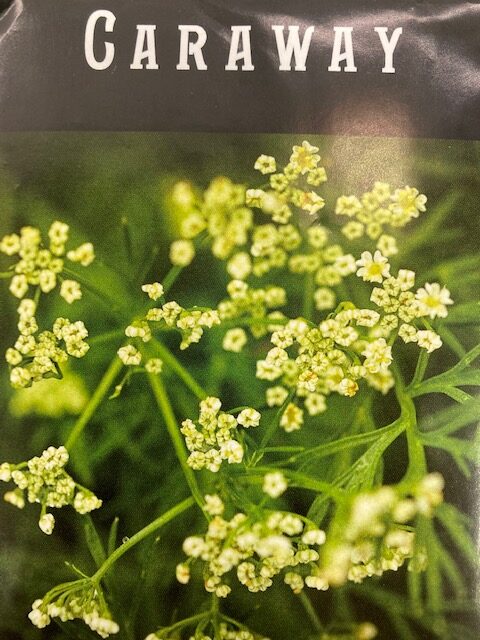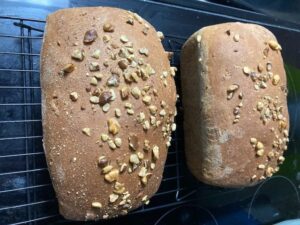
Caraway
Part of the carrot and parsley family, caraway is a companion plant that is beneficial in pest management. Caraway attracts predators that eat aphids, tomato hornworms, squash vine borers, and cutworms, just to name a few! It is also a culinary herb. Caraway seeds and leaves are used in many sweet and savory dishes.
|
N/A |
|
Carum carvi |
|
Intermediate for GA |
|
Easy |
|
3-4 years if properly stored |
|
Biennial |
|
7-20 days |
|
None |
|
Surface Sow |
|
Yes |
|
First year 8” Second year mature height 30” |
|
Seeds need light to germinate Full sun but can tolerate part shade |
|
Second year |
|
March and April |
|
Yes |

Table of Contents
Growing Tips
 for GA
for GA
Easy for cooler climates
When to Start
Spring: Start indoors 3-4 weeks before the last frost date. (March/April for GA)
Transplant: After all danger of frost has passed. (May 1 for Jefferson, GA)
Direct Sow: As soon as the soil can be worked in the spring. Around the last average frost date. (Late March-Early April for Jefferson, GA)
Fall: Direct sow in the fall. As caraway is in the carrot family, use the fall planting dates for carrots. (Aug 20 – Sep 15 for GA)
How to Grow
Start indoors 3-4 weeks before the last frost date. As the seeds need light to germinate, gently press the seeds into the pre-moistened, seed starting mix and place them under grow lights. Or direct sow as soon as the soil can be worked in spring, which is around the last average frost date. Keep in mind, spring planted caraway will not go to seed until the second year. Transplant after hardening off and all danger of frost has passed. Space plants 8-10 inches apart.
Fall plants should flower the following spring. Direct sow as you would carrots.
Care
Caraway likes well-draining, full-sun beds. However, it doesn’t like hot, humid temperatures. In hotter climates, it will benefit from some afternoon shade. This is what makes it a bit challenging for GA. Planting in the fall maybe a good way to get around the hot, humid summers of GA. Good moisture is needed for the first year. Keep the leaves dry during watering, use a soaker hose or drip irrigation. Stop watering once the flowers have formed. “Persistent wet conditions during flowering could result in a fungi-causing blight that can cause severe loss, especially to the seed-producing flowers. Once blight is established in a field or on a farm, it will be there for a long time. Use a 2-5 year crop rotation, and clean, disease-free seed.” 1 Plant every year for a yearly harvest.
Caraway is not just good from a culinary standpoint, it is also an excellent companion plant. It is beneficial in pest management as caraway attracts predators that eat aphids, tomato hornworms, squash vine borers, and cutworms, just to name a few! Give a good layer of mulch in the fall for winter protection.
Harvest
The entire plant can be eaten. Leaves can be harvested throughout the growing season of the first year and are used in salads, stews, and sauces. Harvest the seeds from the flower head as soon as they turn brown. (Seeds form in the second year.) The root is also edible and can be treated like any root vegetable.
How to use
The roots can be used like carrots or parsnips. While leaves can be eaten raw in salads or added to stews. The seeds give rye bread that characteristic taste and are tasty paired with cheeses, potatoes, and sausage. The seeds are also often used as an ingredient in pickles. I like to add a teaspoon or 2 to my homemade wheat bread. It makes good sandwich bread.
My personal experience
I found caraway easy to germinate. My plan with it was to use it mainly as a companion plant. Although, I like the seeds in my homemade wheat bread. So, I’ll grow more at some point to get seeds from it. I planted it near the zucchini and in the potatoes as it is supposed to attract beneficial predators that will eat common pests that are a nuisance to zucchini and potatoes.
Since caraway is a biannual and should flower in the second year, I wasn’t sure how this would work in the first year. It did end up blooming, which was a surprize. I planted them in the corners and by the sides of my raised beds. This way no matter what I planted in the beds next year, they wouldn’t be in the way.
Unfortunalty, since I need to replace all my raised beds due to warping of the sides, I’ll have to start all over next year with brand new seedlings. As this is the case, I won’t try to do any overwintering protecton this year since the plants will have to be removed anyway. I’ll update this as I get more information.
Pro Tip!
Incompatibles: Fennel
Grows well with: Cilantro and peas
Seed Saving

Isolation Distance
Wind and insect-dependent and biennial, caraway can cross other caraway varieties and should be separated by 1 mile for reliable distance isolation. Allow seeds to mature and dry on the plants before harvesting.
Instructions
Plants will bloom in the 2nd year.
When the seeds are dark brown they are ready for harvest. Bagging blooms are a good option to keep the seeds from dispersing before harvest. Cut the flower stocks/umbles off and place them in a paper bag. Let the seeds fully dry in an open paper bag. This could take a week. Then shake the bag to release the seeds.
Seeds and finer chaff are easy to separate by a variety of methods. One way is to use two screens of varying mesh, one a little smaller than the seeds and the other a little larger. The first screen lets anything smaller than the seeds fall through, and the second lets the seeds through and stops anything larger.
Features
- Companion Plant
- Attracts pollinators
- Attracts hummingbirds
- Drought tolerant
- Cold hardy
- Culinary
- Heirloom

One source said to avoid planting near dill or fennel as this can affect the taste of the caraway seeds.
In hot, humid climates, consider fall planting to try to skip summer entirely. Seeds will be produced the following spring.
If you can’t decide between caraway and yarrow as a companion plant and you have children or pets, choose caraway. Yarrow can be toxic if eaten in large amounts. Caraway has the same companion plant benefits as yarrow without the potential danger to children and pets.
You May Also Like:
Companion plant Yarrow
Companion plant Alyssum
Companion Planting: How to use flowers to help control pests.
Trap cropping: How to keep pests out of your main crop.
Whole Wheat Bread

My Whole Wheat Bread with Black Walnuts Picture by Elizabeth Jones
Ingredients
1 package of dry yeast. (2 1/4 teaspoons)
2 cups warm water
1/4 cup melted butter
1/8 cup molasses
1/4 cup honey (I use local sourwood honey)
1 teaspoon salt
3 cups whole wheat flour
2 cups white flour (I use all purpose)
Optional
1/2 cup black walnuts with more for the top. Makes a good bread for peanut butter toast.
1-2 teaspoons of caraway Makes good sandwhich bread.
Instructions
(I use a bread machine to make the dough.)
Dissolve honey, molasses, warm water, and yeast. Let it get foamy. Then add the rest of ingredients by following the instructions of your bread machine to make dough.
After the bread machine as made the dough. Turn onto a floured surface and punch down. (Knead a little bit.) Cut dough in half and shape into 2 loaves. Place them into 2 greased loaf pans. Cover the pans with Saran wrap or salad bowl covers and place the pans on the counter. Let them rise at room temperature until double, about 1 hour.
Bake at 375 F for 35-40 minutes. When they are done, the tops should be brown.
Lean bread is done when it reaches an internal temp of 190 F. Enriched dough (adding of butter, eggs, mik) is done at an internal temp of 200 F.
Another way to check for doneness, is to thump the bottom of the loaf and it sounds hollow its done. Mine has always sounded hollow after the 35-40 minutes of cook time. This is the best and tastiest whole wheat bread recipe I have ever done!
Recipe take from “Breads from Amish and Mennonite Kitchens”


Sources:
Edenbrothers.com
Gardeningknowhow.com
The New York Botanical Garden, Herbal Handbook, Clarkson Potter.
